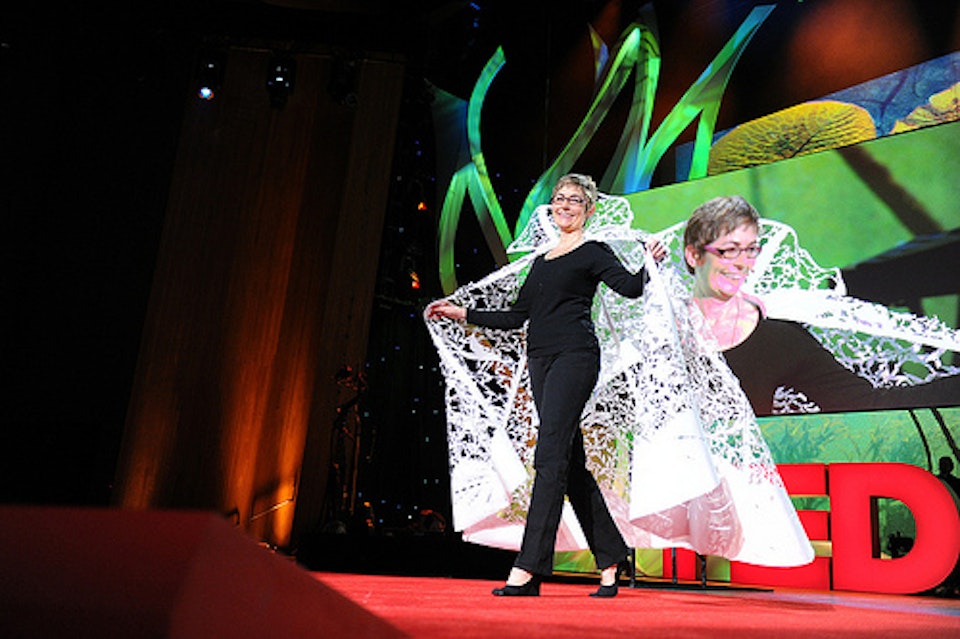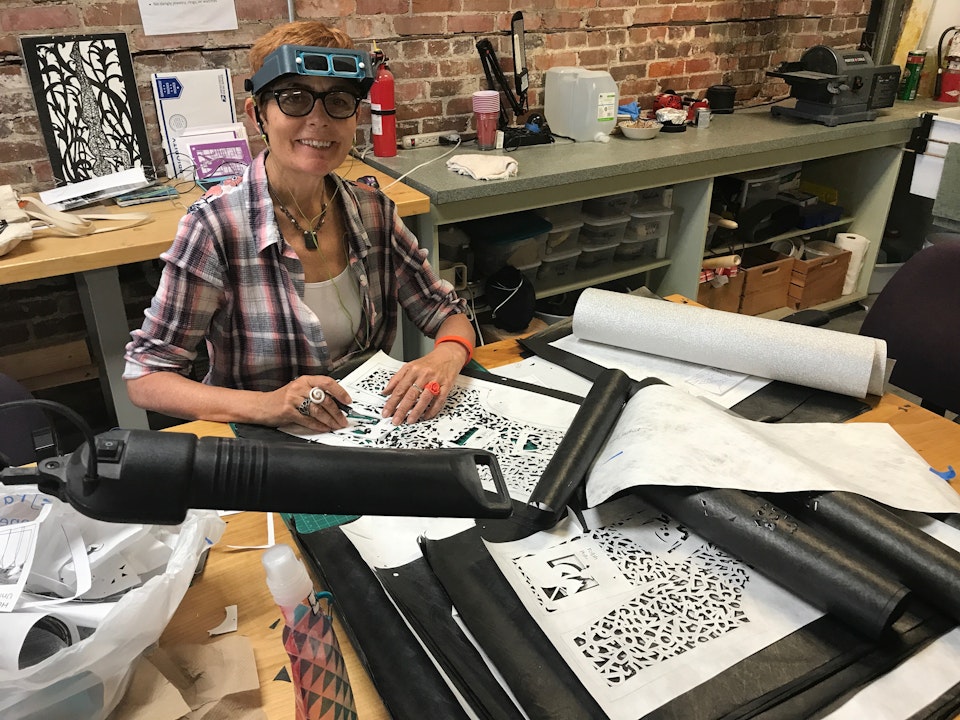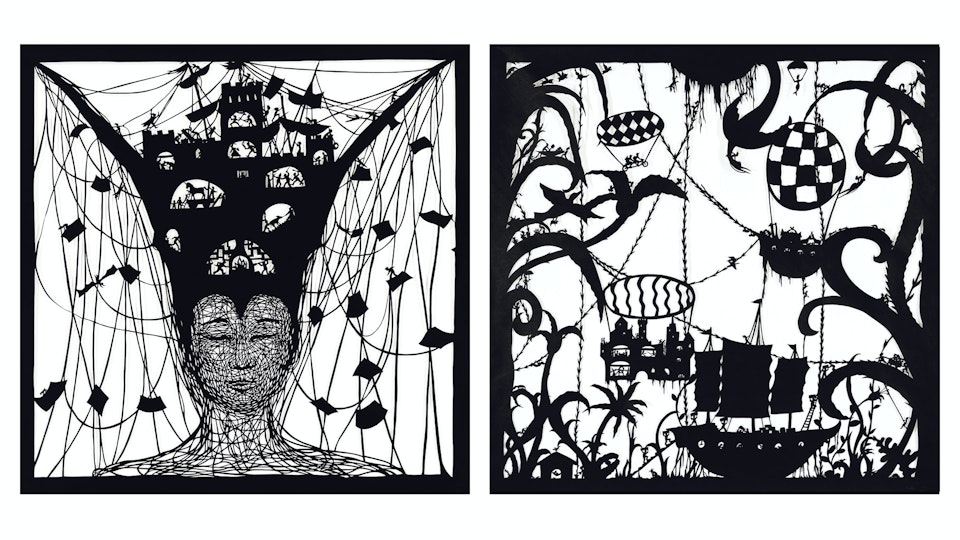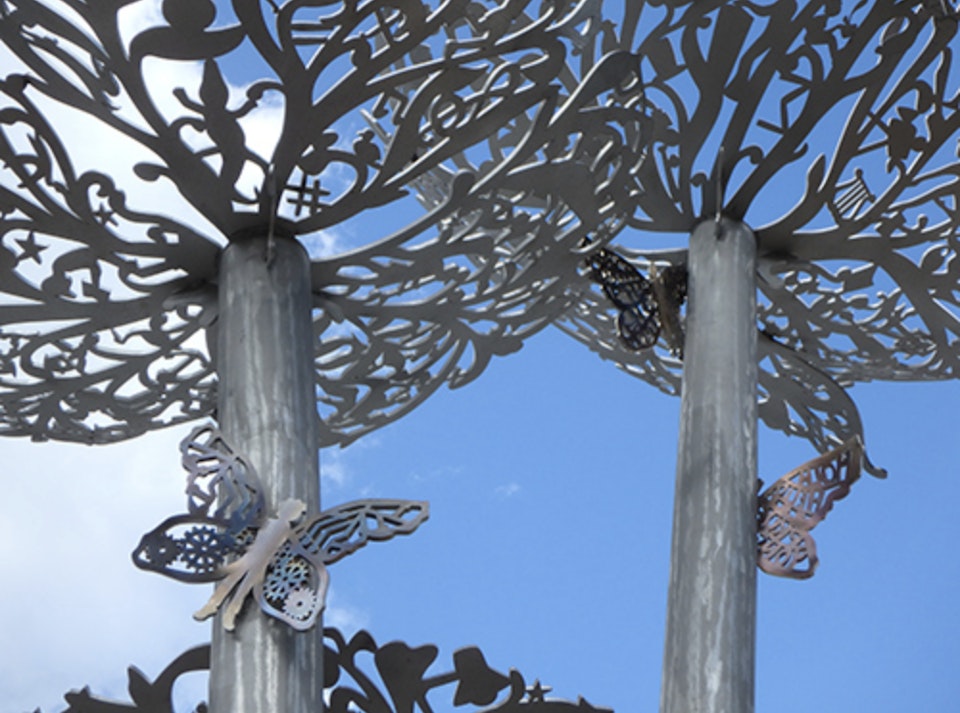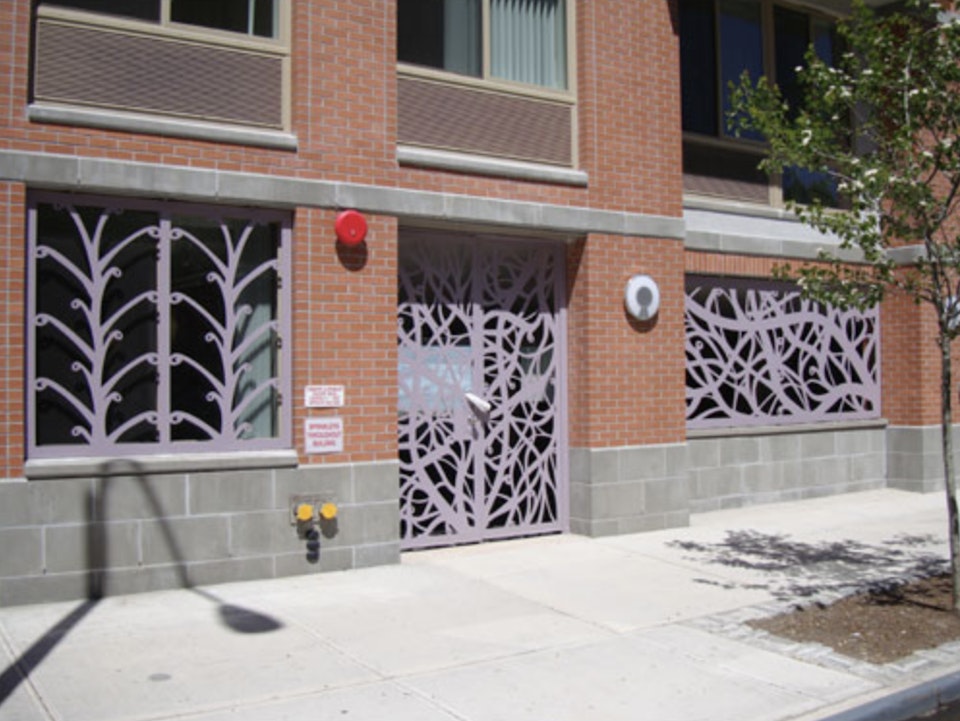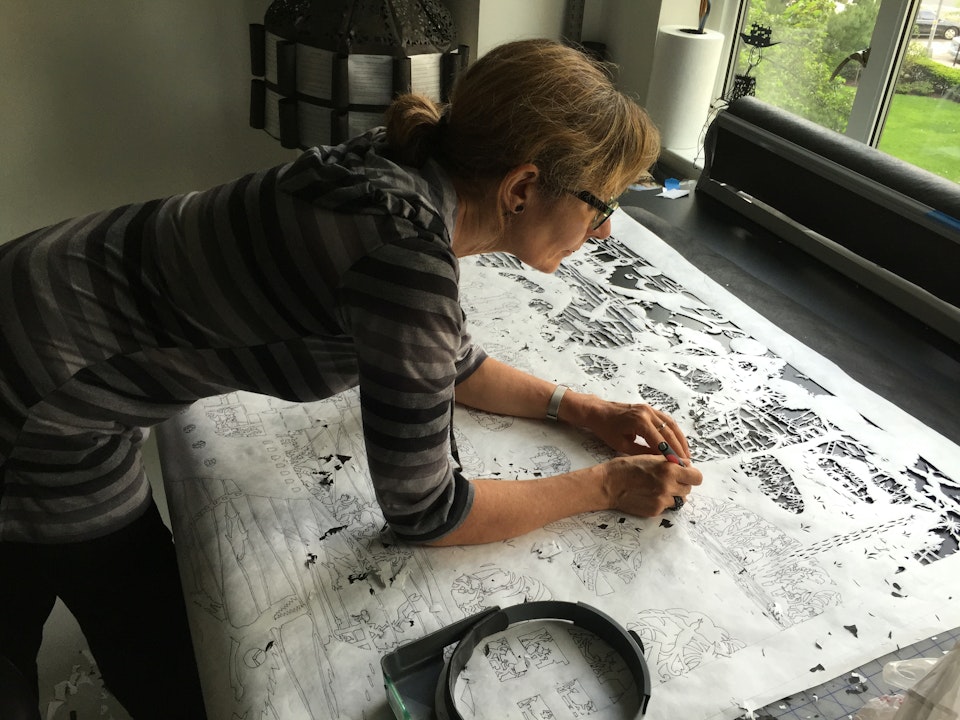February 13, 2021
Living Through Transition: Beatrice Coron Lets Curiosity and Creative Intuition Take the Lead
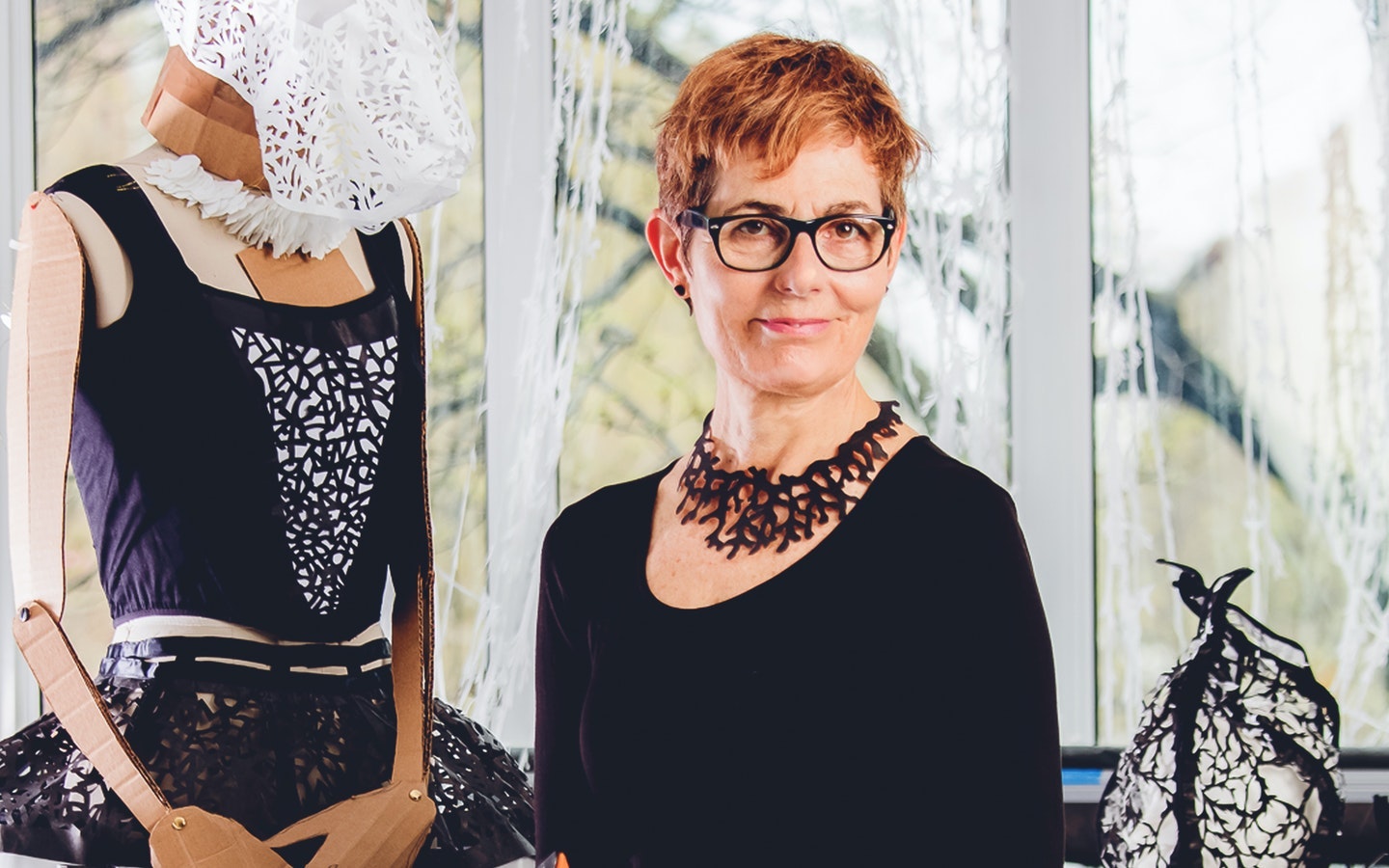
Armed with a blade and an equally sharp wit, Manhattan-based artist Beatrice Coron tells vivid visual stories by getting to “the essential of things.” Seeing her onscreen surrounded by her papercut creations, she becomes the Michaelangelo of paper in my mind – carefully cutting away bits and pieces to reveal the stories she sees hidden in the negative space. Known for her incredibly intricate silhouette designs, her work is owned by major art institutions including the Metropolitan Museum of Art, the Getty, and the Walker Art Center. Across the United States and France, her public art has transformed subways, schools, and airports. In addition to paper and Tyvek, she also works in stone, metal, rubber, stained glass, and digital media. Her TED Talk “Stories Cut From Paper” has garnered over one million views; in it she makes her way onstage wearing a jaw-dropping, papercut cape that will remain imprinted on my mind for a long time. She speaks many languages but is most fluent in the language of silhouette, always experimenting with empty and full shapes that cast captivating shadows. She moves freely between two- and three-dimensional space, immersing viewers in the fantastical worlds she creates to help us see our own in new ways.
Beatrice wearing her “magic cape” during her TED Talk “Stories Cut From Paper.” Photographed by James Duncan Davidson.
Her artistic journey is far from ordinary. Never having been one to follow societal norms, Beatrice followed her curiosity instead, from her native France to Egypt, Mexico, China, and the United States. Her whole life has been one of transformation – moving countries, hopping from one odd job to the next, and exchanging endless hellos and goodbyes, ideas and stories. “I was never really interested in a career or anything,” she explains. “I just made things as they arrived. It takes a lot of guts to be an artist...you have to deal with rejection. I started to be an artist at around eighteen, but I couldn’t deal with the art world. So I put it on the backburner and did other things.” After spending two decades as a shepherdess, truck driver, factory worker, cleaning lady, and New York City tour guide among other things, her creative intuition led her back to her teenage ambition. At forty years young, she reinvented herself once more as an artist.
Finding her footing in the art world
When I ask how she arrived at this life-changing decision, I’m tickled by her response and dry sense of humor. “At 40, you begin to have people around you who are dying, disappearing. Time is not elastic anymore! I thought, if I want to do something, I better move and do it right now, because after it will be too late!” We share a laugh, and she continues. “I’d always wanted to be an artist, so it was like, okay – maybe it won’t go anywhere, but I really have to try 200%. And it’s good to start something older because you’ve done a lot of other things, and you’ve learned a lot about what people say...and what they can do. People want to help you – they say, ‘Do this, register, pay money, it will be so good for you.’ Uh-uh, I’ve heard this one before.’” It’s true of any industry, but the art world can be particularly overwhelming and callous; there are those with good intentions, and those looking to capitalize on naivete. For Beatrice, re-entering the scene with a finely tuned BS radar gave her the clarity of mind that can only come from maturity and life experience.
Beatrice hard at work during artist in residence in Pocosin, NC. Photo by Marlene True.
Her plan at first was to focus on illustrations and develop her style over time, but she soon realized how difficult it was to get any illustration work. So she tried a different strategy, scouring message boards for calls for artists and applying to every free one that she could – creating series after series of illustrations and papercuts exploring a variety of themes in the process. This systematic approach allowed her to build a body of work and find her artistic voice. “I didn’t have anything to show at the beginning, so I really had to flex that muscle of creativity – to take any subject and create, create, create,” she explains. “It was my way of [finding] a shortcut to creation.” As she was putting her portfolio together and sharing it with different people to get their opinions, someone encouraged her to take her work to the Center for Book Arts. There she made even more connections and progress, and discovered how much she really enjoyed creating artist books. As she started to make and sell more of her art, Beatrice began proposing and presenting her work to museums and galleries. “It’s easier to go see curators than to see galleries,” she says. “They have guidelines about what the museum wants to collect – it’s not about their personal taste. So I find it very civilized because they just look at the work. You don’t have to be afraid...it’s not about you, or connections, or looking a certain way, which I find very liberating.”
Left: “Citadelle”, cut Tyvek, 2015. Right: Album art for “Come Tomorrow”, Dave Matthews Band, 2018. Photo by Etienne Frossard.
Action is the opposite of fear
Nevertheless, she’s quick to point out that for every successful proposal, there are hundreds of rejections. “It doesn’t get easier!” she admits, laughing. “[The trick is] to apply very early, so that when you get the rejection, you don’t remember you applied!” As we talk, I find myself taking mental note of the lightness and levity that Beatrice brings to everything we discuss. She seems unflappable. I can’t help but be charmed by her casual brand of fearlessness. It feels effortless. What’s her secret? She smiles and shrugs. “My philosophy is that it’s too late to be pessimistic! Fear is useless. It’s a waste of energy. The opposite of fear is action...to move in any direction, to get better, to try to see how you can magnify the ‘pluses’ and hide the ‘minuses’ under the carpet.”
I wonder aloud if this perspective on fear, this knowing, is a given that comes with living a transformational life like she has. To this she replies matter-of-factly, “We [live transformational lives] every day.” These words hang in the air for a moment before I register how quietly revelatory they are. She goes on. “Nothing is staying static. Life is movement. It’s energy. It’s going from day to night, to night to day. You cannot stay still.” But what about those of us who feel stuck, I ask? The master of reframing shares her wisdom. “Even if you are not moving forward, you are always moving. Sinking is still moving. Sometimes you might want to disappear. Sometimes it’s good! We make a choice. As long as you can move, you can still try things – pushing yourself, connecting with other people and finding a way...there is always something you can do with your mind. By hoping, by learning, by dreaming. It is all movement.”
Right: “Garden of Knowledge”, stainless steel, University of Florida-Gainesville, 2020. Photo by Robert Perez. Left: Window guards and rails in the Bronx, 2010.
For Beatrice, public art is about solving problems with creativity and beauty.
“Creativity is a great strength for moving things”
Movement and connection are themes that seem to permeate Beatrice’s work. Cut from single pieces of paper or Tyvek, the stories she creates are simply starting points. Through them, she hopes to trigger people’s imaginations, move them, and engage them as narrators. That’s the beauty of wordless storytelling. Everyone can be a narrator. We all come away with our own versions of the visual stories laid out before us, informed by our own experiences and perspectives. It’s a reminder that we all have our own stories to tell – stories shaped by the visible and invisible forces that connect us all. This relationship between the individual and the whole is the space her work inhabits. Our individual stories are what give meaning to the world, and what make it whole and coherent. “You need everybody. You need people who make science fiction, you need people who make crazy worlds. And you need art. Everything is connected,” Beatrice says. “Creativity is a great strength for moving things. It’s something that everybody has. We have to find balance – try to align what we think is right, with what we do.”
This couldn’t be truer, especially now. Creating a more balanced world seems daunting, impossible even. But finding balance within – for ourselves, as individuals – seems less overwhelming and much more doable. I think about what would happen if we all focused inward and found ways to write the best versions of our own stories, and it makes me hopeful. As Beatrice says, “You just have to dream a little more, a little harder. You have to start where you are....and wherever you are is a good place to start. The future is not written. We are writing it.”
Beatrice working on another one of her papercut masterpieces. Photo courtesy of the artist.
Written by Carla Ballecer
For more stories, tips, and new artist updates, subscribe here.
